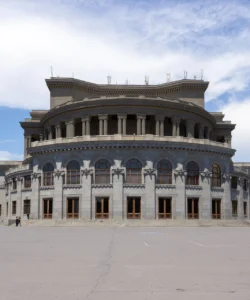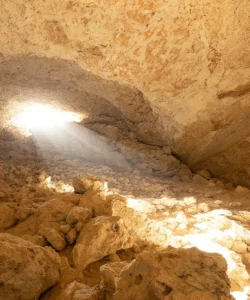Zvartnots Cathedral (Armenian: Զուարթնոց, Zvartnots), meaning “place of celestial angels” or “heavenly host,” is a remarkable 7th-century Armenian cathedral, now largely in ruins. Located near Vagharshapat (Etchmiadzin) in Armenia’s Armavir Province, it is a UNESCO World Heritage Site recognized for its unique circular design and profound influence on regional architecture.
Listen to an introduction about Zvartnots Cathedral
Name and Address
- Name: Zvartnots Cathedral (also referred to as St. Gregory in some historical texts, and Zuart’nots’ or Zuart’noc’ in scholarly works). The name “Zvartnots” is believed to derive from “zvartun” (զվարթուն), meaning “angel,” or “zvartonk,” a pre-Christian word for a spirit that awakened the dead.
- Address: On the outskirts of Vagharshapat (Etchmiadzin), Armavir Province, Armenia.
- Location: Approximately 15-20 kilometers (9-12 miles) west of Yerevan, and about 4 kilometers (2.5 miles) from Vagharshapat, near Zvartnots International Airport.
How to Get There
Zvartnots Cathedral is easily accessible from Yerevan, often visited in conjunction with Etchmiadzin:
- By Car/Taxi: A quick 20-minute drive from Yerevan. Taxis and ride-sharing services are readily available.
- By Public Bus/Minibus (Marshrutka): Take bus number 111 (or 202/203) from Yerevan’s Kilikia Bus Station (also known as Central Bus Station) directly to Zvartnots Cathedral. The journey takes about 25-30 minutes.
- Organized Tours: Many tour operators offer combined day trips from Yerevan that include Zvartnots Cathedral along with Etchmiadzin, given their close proximity.
Landscape and Architecture
Zvartnots Cathedral is a testament to the ingenuity of early medieval Armenian architects, standing as an evocative ruin that still conveys its former grandeur.
- Original Design: Built between 643 and 652 AD under Catholicos Nerses III the Builder, Zvartnots was a circular-plan aisled tetraconch. This unique design featured a Greek cross-shaped interior enclosed by a circular exterior. It is believed to have had three diminishing levels, reaching a height of 45-49 meters (148-161 feet), topped with a massive dome.
- Materials and Construction: The cathedral was constructed from tuff and basalt stone, with a strong engineering design intended to last for 1,000 years.
- Decorative Elements: The exterior was lavishly decorated with blind arcades, intricate relief carvings of pomegranates, grapevines, figural ornaments, and symbolic eagle capitals. Inside, there were frescoes and sculptures.
- Ruins and Reconstruction: The cathedral collapsed in the 10th century (likely due to an earthquake, though repeated Arab raids are also speculated). Its ruins lay buried until excavations in the early 20th century uncovered the foundations and various architectural fragments. These remains have been partially reconstructed, allowing visitors to visualize its original form.
- Archaeological Site: The site also includes the ruins of the Catholicos’ palace, a medieval winery with a wine press and stone tanks, and even structures dating back to the Urartian period (7th century BC), including a cuneiform inscription.
- Museum: A museum on-site displays artifacts found during excavations and provides detailed information on medieval Armenian architecture and the history of Zvartnots.
What Makes It Famous
Zvartnots Cathedral is celebrated for several significant reasons:
- Unique Architectural Design: Its innovative circular exterior enclosing a tetraconch interior was groundbreaking for its time and had a profound influence on church architecture across the Caucasus and beyond.
- UNESCO World Heritage Site: It was inscribed on the UNESCO World Heritage List in 2000, along with the churches of Etchmiadzin, for its outstanding universal value in demonstrating the evolution of Armenian ecclesiastical architecture.
- Historical Significance: Built on the site where King Trdat III and Saint Gregory the Illuminator (who converted Armenia to Christianity) are said to have met, it marks a pivotal moment in Armenia’s adoption of Christianity as a state religion.
- Early Christian Symbolism: The cathedral was dedicated to St. Gregory the Illuminator and likely housed some of his relics, making it a key religious site.
- Impressive Scale (Even in Ruin): Despite being a ruin, the remaining foundations, columns, and reconstructed sections convey the sheer scale and architectural ambition of the original structure.
Differences from Some Other Landmarks
Zvartnots Cathedral distinguishes itself from other Armenian landmarks, such as Geghard Monastery and Tatev Monastery, in several ways:
- Architectural Form: Unlike the rock-cut integration of Geghard or the fortified cliff-edge setting of Tatev, Zvartnots is famous for its unique central-domed, circular-exterior plan, a distinct architectural type that influenced many subsequent churches.
- State of Preservation: While Geghard and Tatev are largely preserved monastic complexes (albeit with some damages and restorations), Zvartnots primarily exists as an archaeological ruin. Its fame lies in what it was and the insight it provides into architectural innovation, rather than its current functional completeness as a monastery.
- Location Context: Zvartnots is located on a relatively flat plain near a major city (Vagharshapat/Etchmiadzin) and Yerevan’s airport, making it easily accessible as an archaeological park. This contrasts with the more remote, dramatic natural settings of Geghard and Tatev, which require specific journeys into gorges or mountainsides.
- Emphasis on Innovation: Zvartnots is often highlighted as a pinnacle of architectural experimentation and sophistication in the 7th century, representing a bold step forward in church design that influenced a wide region.
Zvartnots Cathedral Photos:

























































